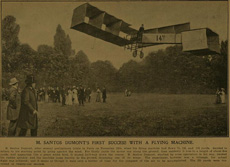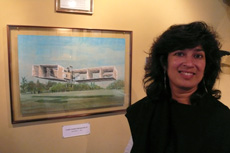
|
|
Santos Dumont |
The 14-bis – Objections – Ingrained fact – A contract – Cluster Ballooning. (Map this!)
I have it on good authority that the Wright brothers were NOT first in flight. That distinction belongs to Alberto Santos Dumont of Brazil. Santos Dumont was born in Brazil and spent most of his aeronautical career in France. It was there that he designed and flew the “14-bis”, the name of his aircraft that has the distinction of producing the first powered heavier than air flight in Europe. On September 13th, 1906, Dumont took to the air with the 14-bis, and found his way into the history books. Or not, it depends on who you talk to. Brazilians will stick to this story as it is what they have learned in school.
 |
|
The 14-bis |
Visiting the Santos Dumont house in Petropolis, which showcases his designs, one cannot be but impressed by this man’s talent and asthetic. It certainly seems within the realm of possibility that he was the first to fly, so why is that distinction, at least in the United States, awarded to the Wright Brothers? I set about to do some research to try and untangle the various claims, and find out why Brazilians find the December 17, 1903 flight at Kitty Hawk unacceptable. There are two reasons most frequently cited: 1) The Wrights worked in secrecy and had few witnesses and 2) Their use of a catapult and rails to achieve flight speed invalidates their record. These objections are explained by the fact that Kitty Hawk did not have many residents to act as witness and that the catapult was used only when there was a sufficiently strong head wind – details can be found on the Wright Brothers’ website.
 |
|
At the Dumont museum |
So why do Brazilians still make the case for Dumont? One of the arguments put forth on the Wright Brothers’ site is that a 1937 dictatorial regime undertook a historical revision that promoted nationalistic thought and all things Brazilian, and wrote Dumont’s name into all textbooks that are published today. It is an ingrained fact of Brazilian culture that Dumont flew first and it is just as difficult for them to accept otherwise as it is for us.
Speaking of us, I would like to present an excerpt from the contract the Smithsonian had to sign in order to display the Wright Flyer:
“Neither the Smithsonian Institution nor its successors nor any museum or other agency, bureau or facilities administered by the United States of America, by the Smithsonian Institution or its successors, shall publish or permit to be displayed a statement or label in connection with or in respect of any aircraft model or design of earlier date than the Wright Aeroplane of 1903, claiming in effect that such aircraft was capable of carrying a man under its own power in controlled flight.”
So the Wrights did better than the dictatorship – they legally bound their claim to be first in flight and suppressed information otherwise. The more one digs into the matter the more muddled it becomes, with all manner of people claiming first in flight, Gustav Whitehead being often mentioned.
 |
|
Flying balloons |
Since we are on the topic of aviation pioneers fron the United States and Brazil, I would like to mention Rev. Adelir Antonio de Carli, a pioneer in the field of cluster ballooning, or flying with lots of small balloons. In order to raise money for a “spiritual rest stop”, he attached himself to 1,000 party balloons and flew off into the great blue yonder. Unfortunately for him he flew higher than he expected and turned into a priestcicle as he attained an altitude of almost 20,000 feet. He was in contact with the authorities for part of his trip and was unable to convey his position because he had never bothered to learn how to use the GPS he had taken with him. For his accomplishments he was awarded a rare double Darwin award. In contrast, american cluster balloon pioneer, “Lawn Chair Larry“, attached his Sears Roebuck lawn chair to some Helium balloons and safely floated down after enjoying his inflght snack of beer and sandwiches. Top that Brazil!
The good Rev. Adelir Antonio de Carli should have invested in a BB gun to allow for altitude adjustments.
Thanks for discussing Alberto Santos-Dumont! You can go to http://www.followyourdreams.cc to get activities for the kids and discover a beautiful, bilingual children’s book about him, featured at the Smithsonian Museum of Air and Space, when he was honored on the centennial of his flight of 14bis.
Fred,
I think he did have some way of releasing or popping the balloons but the cold froze his hands. His “aluminum thermal suit” did not prove as effective at conventional high-altitude down clothing. I wonder if the truckers ever got their spiritual rest stop…